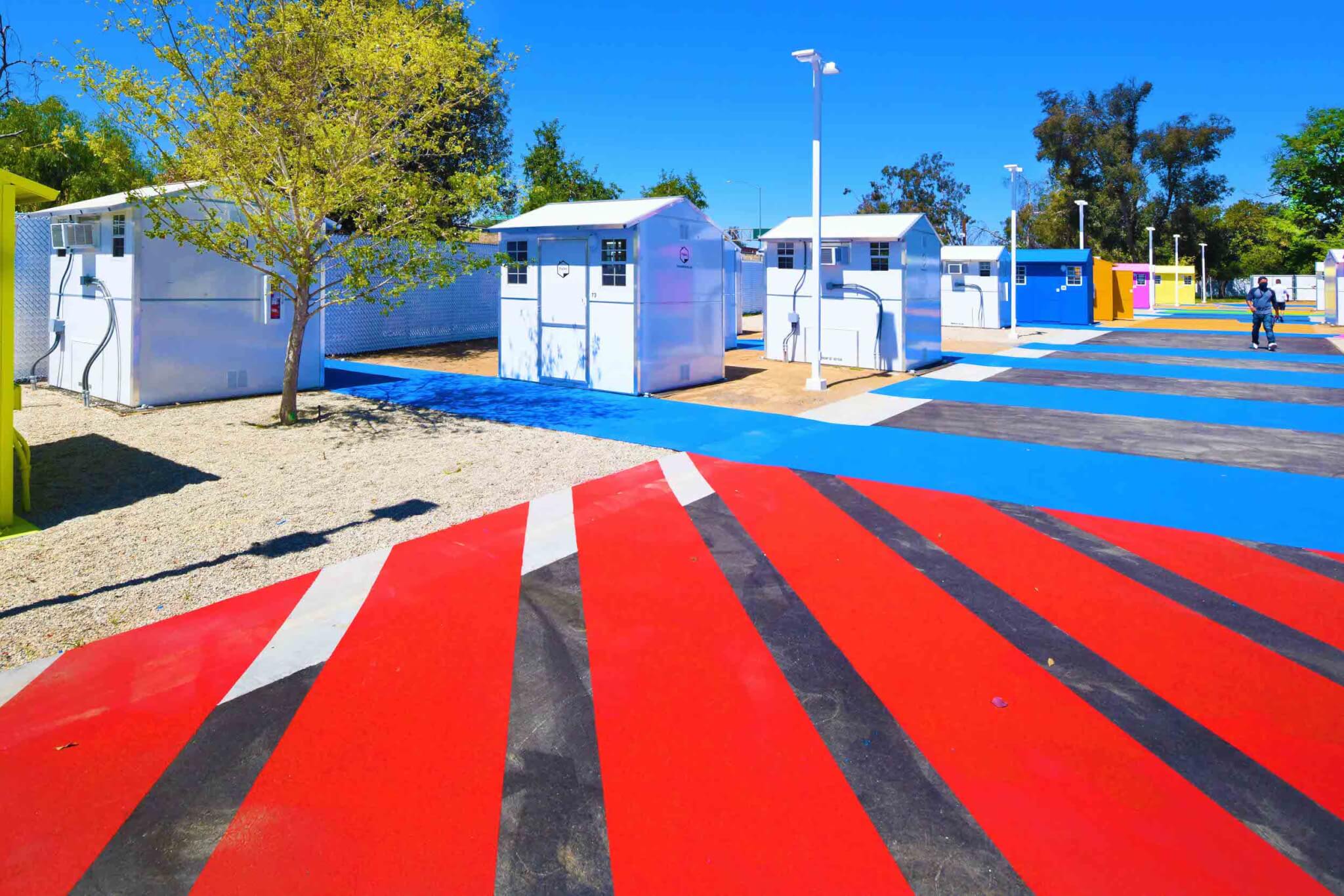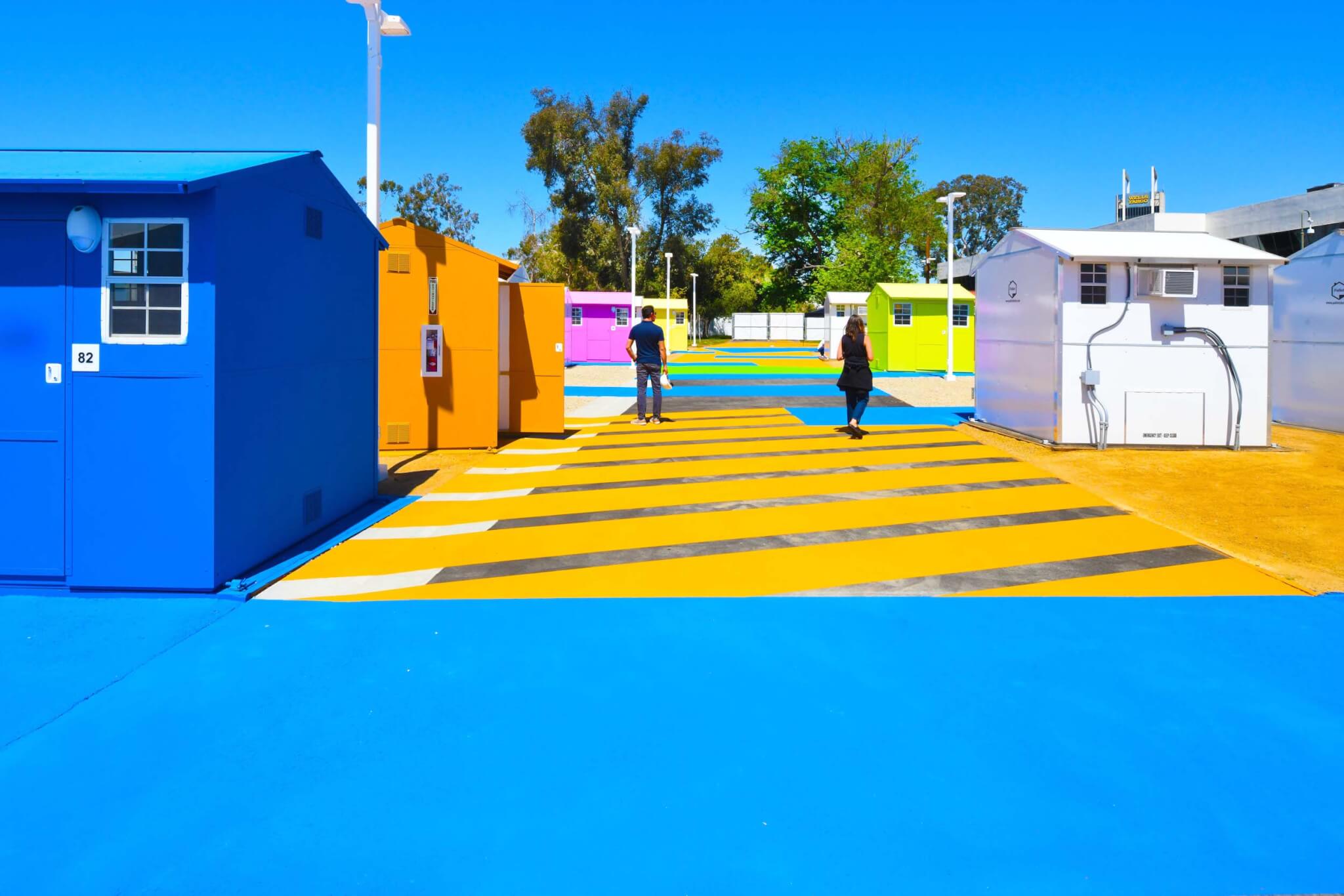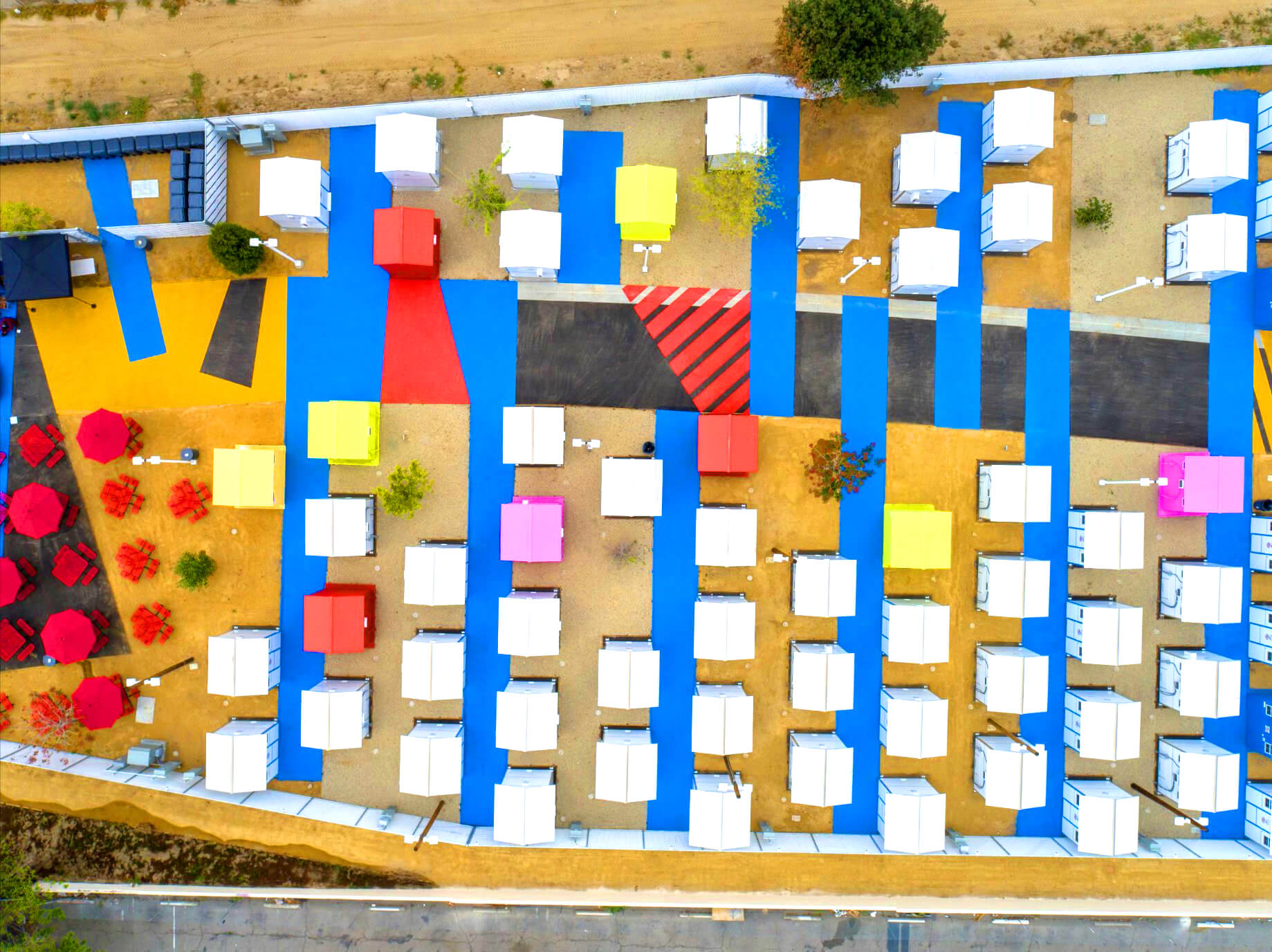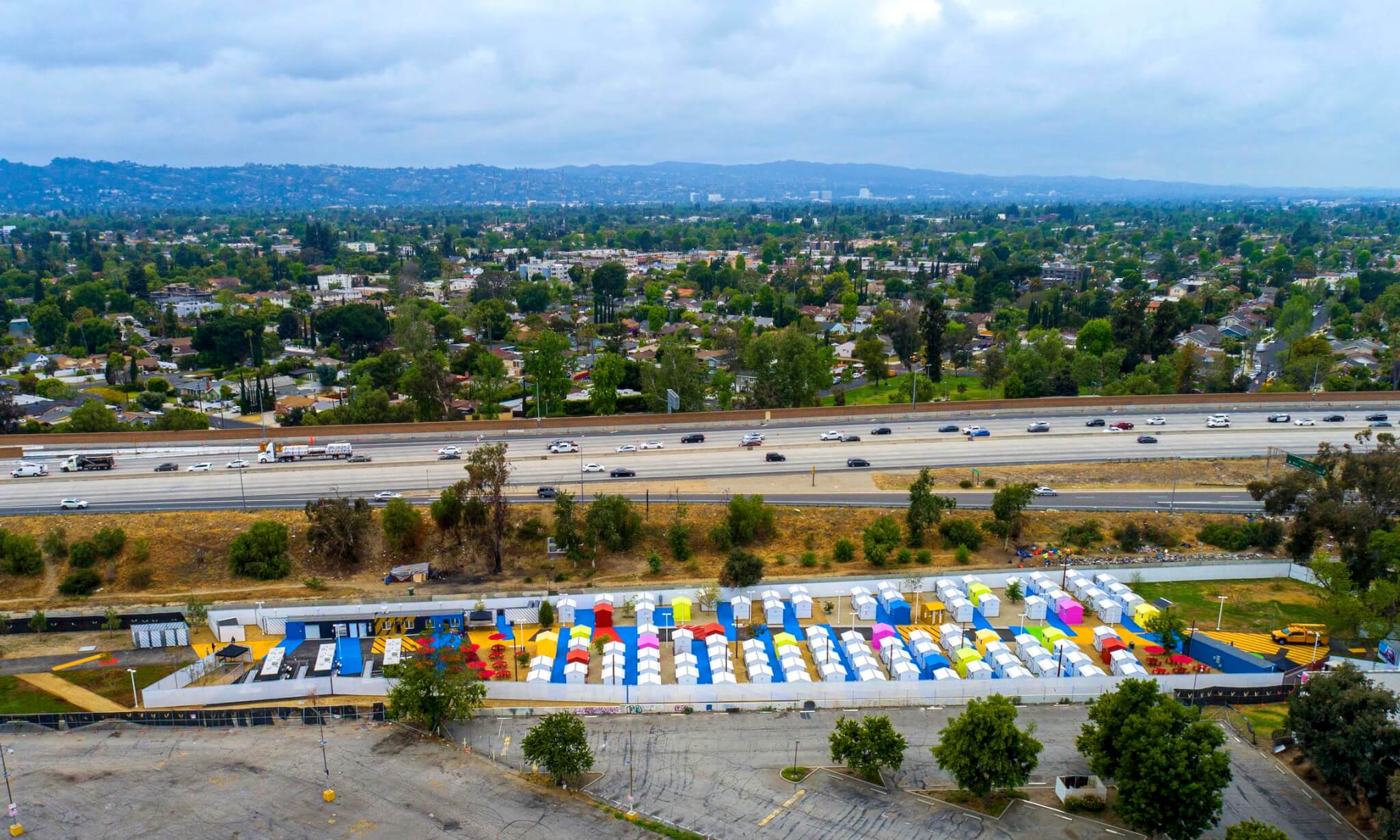When one is driving north on the Hollywood Freeway through the San Fernando Valley, it’s hard to miss a controversial new urban type here in Los Angeles: a fenced compound with rows of little gabled boxes, like jumbo Monopoly houses, and bold patches of color painted across the ground and some of the quaint structures. Alexandria Park Tiny Home Village, as it is formally named, is a new kind of homeless shelter. Opened in North Hollywood in April 2021, it consists of 103 so-called tiny homes, freestanding 8-foot- by-8-foot rooms that house up to two residents each. Bathrooms, showers, and a laundry are on-site. The shelter is run by the nonprofit Hope of the Valley, which provides security, thrice-daily meal service, and case management.
Alexandria Park is one of ten such shelters in L.A., all of them built within the past two years on municipal land with City funding, though run by independent service providers. In these villages, residents live in 64-square-foot buildings that include two beds, shelving, AC, windows, and a lockable door. Assembled from prefabricated panels, the structures probe the extremes of the concept of the tiny home— they are spartan and utterly compact.
Critics have taken issue. A forum of mayoral primary candidates this spring became heated after the progressive activist Gina Viola repeatedly referred to the structures as “tiny sheds,” vexing city council member Kevin De Léon, who praised a recently opened village shelter in his district. Viola’s words echoed a common refrain of activists.

But amid the controversy, the construction of village shelters in L.A. matches their growing popularity, including another handful in Los Angeles County, at least a dozen more across California, and still others nationwide. Pallet, the company that manufactures the sleeping structures used at Alexandria Park, has built approximately 2,500 shelters for over 90 villages around the country since 2020.
By the last national point-in-time count, in January 2020, immediately before the COVID-19 pandemic, there were more than 580,000 people experiencing homelessness in the United States. As the pandemic continues to exacerbate housing insecurity across the country and has led to more unhoused people living on the streets, tiny homes are seen as a speedy and nimble solution to the problem. The discrete units also offered socially distant shelter beds at a time when the virus was causing congregate shelters to reduce their number of occupants—although in L.A. shelters have now started doubling up residents in the two-bed structures. The tiny home villages are just one aspect of a multipronged effort by L.A. mayor Eric Garcetti to add shelter beds during COVID-19, but their presence throughout the city is conspicuous.
Most Angelenos will encounter the villages only in chance glimpses while moving along the city’s streets and freeways. At Alexandria Park, the village’s high visibility from the freeway only enhances its inscrutable presence at street level, where it is set back from Laurel Canyon Boulevard at the far end of a narrow park that sits between the freeway embankment and the parking lot of a dilapidated shopping center. Except for a gravel path along the north side that links its two ends, the project occupies the whole width of the park and is enclosed with a chain-link fence. Fitted with white slats, the fence prevents any views through; only the tops of the gables peek out above it.
To get a better look, I met architect Michael Lehrer for a tour. His eponymous firm designed the Alexandria Park village alongside City architects and the Bureau of Engineering. As we walked down the central spine of the linear village—a fire lane that Lehrer Architects reconceived as an organizing boulevard—he described a basic design principle to “create a sense of arrival, a sense of place, a sense of community, some notion of procession.”

Setting aside the guarded, nondescript gate through which I entered, I could see Lehrer’s vision had come to fruition. The loosely curved lane runs between outdoor seating areas and is intersected by perpendicular blue paths that organize the rows of shelters. These blue bands crisscross the lane in a collage with geometric patches of color splayed out from the handful of painted structures. The judicious use of color goes a long way in breaking up the monotony of 100-plus identical structures. Manufactured by Everett, Washington–based Pallet, these units were preselected in the city’s initial bridging document for the project. In fact, Pallet’s structures were used for all the city’s tiny home village projects, including the four others by Lehrer Architects. (Alexandria was their second.) Pallet’s shelters are made of structural aluminum framing with composite FRP panels and a proprietary composite on the flooring. The 7.5-by-8.5-foot footprint (there is also a 7.5-by-13.5-foot, four-bed version) derives from sizing the panels to flat-pack into a shipping container.
With these buildings a given, the architects’ influence at Alexandria is most apparent in the layout of the 17 side streets long which they stand. Again, paint does the heavy lifting. Lehrer described the use of color in terms of “the music of city making.” The few painted shelters are placed near the road for visual orientation as one walks down the lane. While the blue bands “give form and measure to the street, they define the ground plane, give it scale, and project each neighborhood street onto Main Street,” Lehrer said. Townscape in miniature, in other words.
The temperature was in the high 90s on the day I visited, so most residents kept to their air-conditioned rooms, but during lunchtime there was a convivial atmosphere in the shade of a marquee tent that had been set up over one of the seating areas. Residents sat at tables reading or chatting in small groups. Reps from a cell phone company were distributing free tablets. A resident named José sat singing along to music in his earphones and smoking a cigarillo. “Talking for myself,” he said of the village, “I think it’s a blessing because we have shelter, we have food, and the most important thing is they can help you stay away from drugs and bad people.”

José told me he had lived on the streets since 2017, mostly in a different park a few minutes up the freeway, until moving to the Alexandria village about seven months earlier. That’s well over the 90-day stay the villages are meant for, which evidences the most significant criticism of the tiny home village program. Beyond issues with the size of the shelters or their construction and administrative costs, there is legitimate concern that L.A.’s recently built shelters are not working as intended—to provide temporary shelter on the way to permanent housing. According to the latest data, the average length of stay in the city’s village shelters is 119 days, and nearly half of the people who have exited have gone to “temporary situations.”
At Alexandria, I spoke to a resident named Curtis, who said he had been living there for 11 months, unable to find permanent housing despite having a part-time job and having applied for an emergency housing voucher. Curtis expressed discouragement with having to continue living in his tiny home, which he likened to sleeping in a closet.
Simply put, there is not enough housing in L.A. and not sufficient political will to build it. A February report by the city controller was critical of the slow pace of a five-year-old program to build more supportive housing, and the city has come under fire recently for the abysmal rate of placing residents with HUD emergency housing vouchers. Given the city’s recent focus on adding new temporary shelters—tiny homes as well as converted hotel rooms and congregate shelters—the situation contradicts the housing-first policy to which the mayor committed early in his tenure.
What most concerns advocates is the fact that all of this coincides with a recent court order by which the city must accommodate 60 percent of unhoused people in each council district before it can legally begin enforcing anti-camping ordinances. Many see the village shelters as part of a push to add temporary shelter beds in various forms to reach that threshold before proceeding to effectively criminalize homelessness.

I raised these criticisms with Lehrer as we sat under the big tent at Alexandria. Although he noted that housing developments in the city often proceed sluggishly—whereas “the waters have parted” for the village shelter projects—his response was one of measured optimism. “None of these things are the answer; they are an answer,” he offered. “And hopefully with every passing year, the palette of possible solutions grows and grows.”
Lehrer also stressed that addressing a problem like homelessness requires experimentation: “You’re doing it with the hope and expectation that it will work. And the understanding that it might not.” The outlook is indeed uncertain, but it appears that the villages will stay around for a while. Pallet provides a five-year manufacturer’s warranty and says its shelters have at least a ten-year life span. As Gykas, a resident I met just outside the gate at Alexandria, jested about the village: “It’s like a private jet. But it’s gonna take a long while.”
Luke Studebaker is a writer and architect living in Los Angeles.










